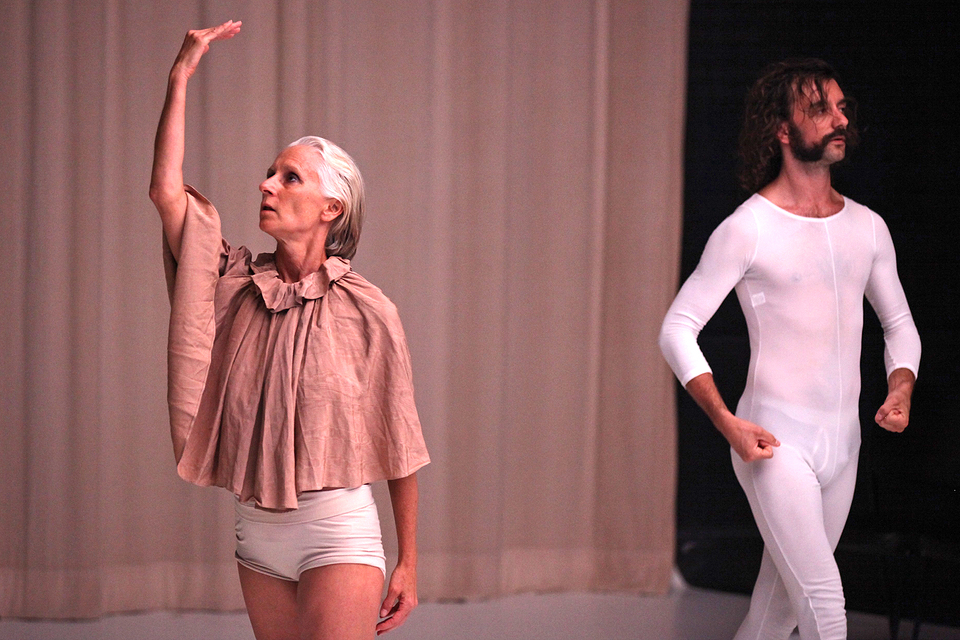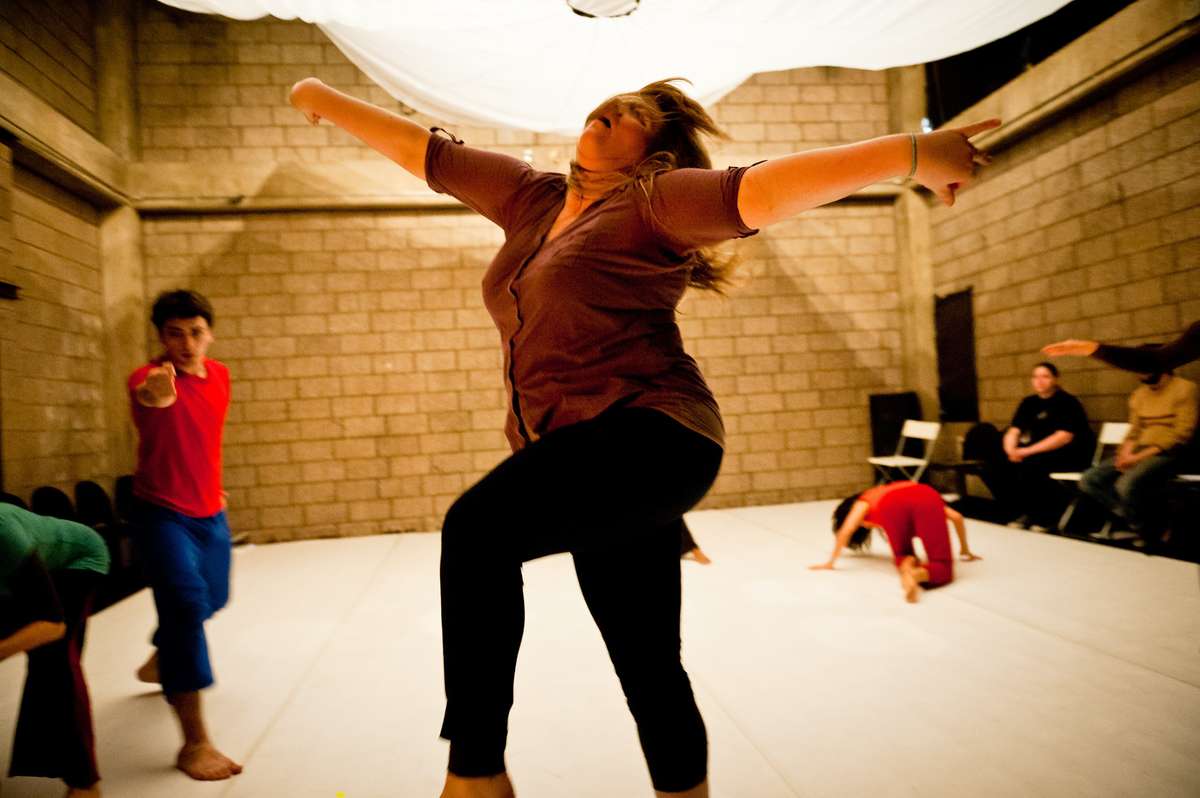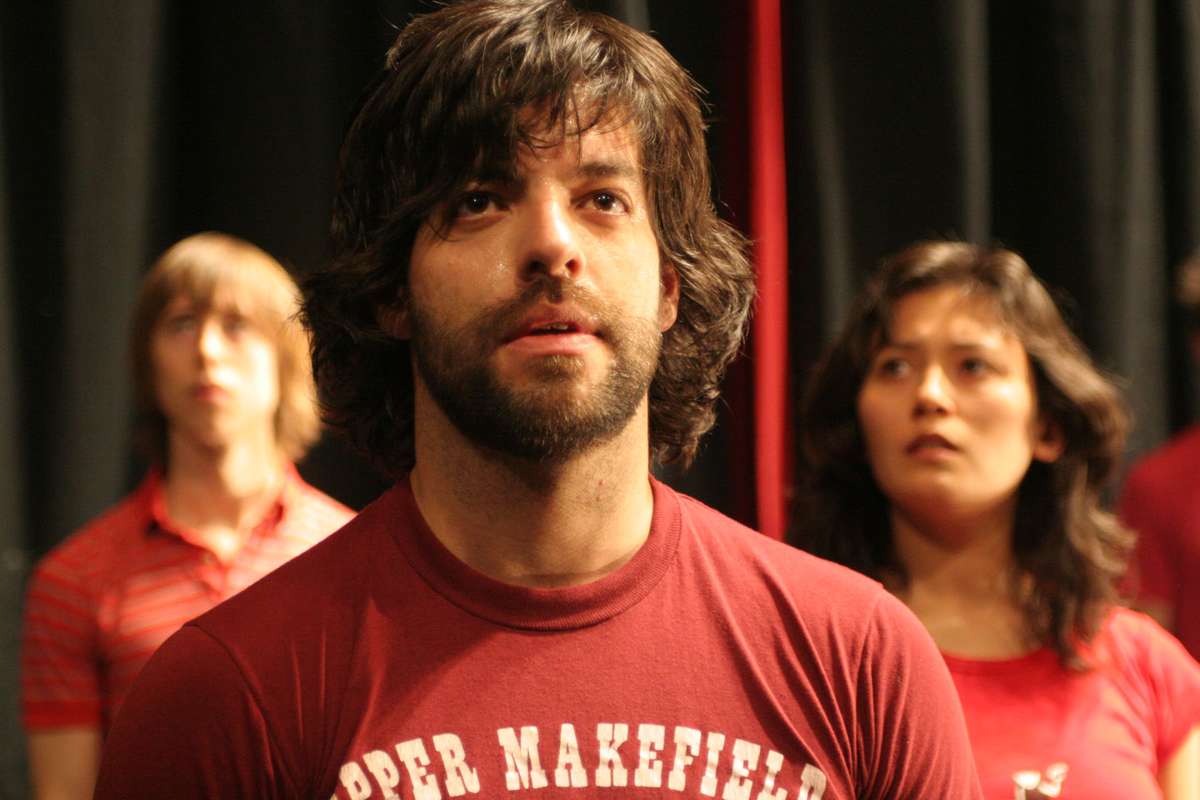A National Conversation About Local Work: the week in dance
Between "McKnight Solo", Joint Project hip hop showcase at Intermedia Arts and following the invite-only circuit for Minnesota Contemporary Dance Platform presented by Northrop and the Walker -- our resident dance critic has had a very busy week.




6:30 pm, Wednesday, La Belle Vie: Corralled by a bank of free shrimp, dance-people swirl around one end of the lounge, hugging, clinking glasses, celebrating the Minnesota Contemporary Dance Platform, a mini-festival geared at raising the profile of Minnesota dance across the nation and the world, for which presenters from all over have been invited to view a selection of Minnesota dance. I say a selection, but it seems like everyone’s here, from the ladies of Ragamala—regal in the middle of the room in Cleo eyes and sharp dresses—to Olive Bieringa and Otto Ramstad with baby in tow, cute, curly-headed, rambling. Sage Cowles gives a toast; general goodwill towards our foremost dance patroness is amplified by the fact that she’s also supplying the champagne. Cheers!
In a side room, post toast, the natural question of the relation between local and national dance arises. Andrew Horwitz of Culturebot, flown in from New York for the Platform, wants to create a livelier national conversation about dance, similar to the conversation that flows around film, indie rock, and American novels – no controversy there. But the national conversation around those other forms can exist because Americans everywhere have access to the same films, music, and books. The same isn’t true of dance—and so far it’s meant that only dance with the New York imprimatur gets national coverage, and then only a thin sort of coverage that people outside dance and outside New York mostly don’t bother reading (and who can blame them?). To get a real national conversation going, Horwitz suggests, dance everywhere needs to get more on the same page, so that when you read about a dance event in Philly, you can go to the theater in Houston and see something connected.
But a combination of long gestation periods, cooperative process, small budgets, and the need for an audience keeps dance local. In Minneapolis, apparently, we’re more given to identity politics than people in New York; who knows why, but I’d bet it’s rooted in experience here. Does this mean a national conversation on dance won’t happen until we give up answering local conditions? I hope not—but the local/national tension is in evidence tonight: Sometimes the energy in the room resembles a deb party, and sometimes it’s more like the scurry you see when you turn over a long-rooted rock.
******
7:30 pm, time to scurry over to the Walker for some securely national, i.e. New York, dance: Miguel Gutierrez’s new And lose the name of action. A Walker commission, And lose the name of action shows the money, time, and talent invested in it at every seam: engaged performances from a stellar cast (including the magisterial Ishmael Houston-Jones), smart sound and design, brilliant costumes from David Tabbert (a snowy taupe capelet, a rippling robe in champagne silk, openwork hot pants, a dress with a train so milkweed-light it daringly showed the performer’s satiny panties when she moved).
But mostly, Gutierrez’s control of the moment shone: his sense of how much or little can occur at once, how to move our attention (slowly, everyone’s heads swivel to catch the just-barely-movement at the side of the space), of when to end a scene (just before or a while after it ends), how to modulate from séance (everyone holding hands while the performers, among the audience, chant or sing) to brainy disquisition (whether in words or flesh) and everything in between. All-but-elided references to Hamlet (the title, some costume elements), a sense of community, anointings of light or spirit or dance, the “useless” yet sacred space of the stage, and, as my notes have it, “somewhere love comes up” – there was a moment, a particular exit, when everything came together in a whirling cloud that I felt to be one thing, though I could not compass it, a storm that brought words and ideas from me but that I could not name. I was delighted, I thought it was perfect; but then it went on. And unfortunately, everything that followed cohered too closely for me around one node, the idea of disrupting the audience paradigm. So, we had one performer trying to erect and protect chairs while others demolished them; we had an argument between those who believe that what they see and feel is a reality and those who know that feeling and seeing are personal reactions to some stimulus. True, the last ended in a delightful round of “Fuck you!” and chase-the-king (Houston-Jones in a crown), but I felt my options close down in those last forty minutes of the performance.
Sidenote: Is the dance style itself—at its most unhinged, tantrum spasms, sudden losses of tone, collapsings and floppings—a thing particular to New York? I liked the older performers’ more controlled, more sustainable-looking version best, even though it could get dull and small. But perhaps if I lived in New York the wild flashes would look less like unacceptable joint risks and more like life.
Duly disrupted, the audience headed up to the balcony bar for the post-show, at which people stood around with the ghastly pallor of having drunk too much champagne a few hours before. Exceptions to this included the ever-fresh Ben Johnson and Philip Bither (curators at Northrop and the Walker) and Gutierrez himself, resplendent in cherry red and a cascade of gold chains.
******
8 pm, Thursday, found me at Intermedia Arts for the unapologetically local Joint Project, for which curator Amy Sackett has brought together various Twin Cities artists with the express purpose of developing hip-hop as a stage dance form. Some of these collaborations flopped and some fizzled, but some caught fire. Arturo Miles’s house dance to Micah Buckley-Farlee’s loops, backed up by Lana Iwaskewycz’s mystic film of a revolving sculpture—part music box, part merry-go-round, part metal lace blur—reached a mesmerizing climax when Iwaskewycz came out to spin the sculpture in real time, dancing with it and casting shadows on shadows from bike headlights in her hands. Yes, I’d dance to that, if I weren’t busy getting hypnotized; the piece has a vortex.
Aside from the video for Brother Ali’s “Mourning in America” (directed by Todd Angkasuwan), the best pieces here felt more promising than fully plumbed—but if you intend on sticking around to see what’s next, that’s no problem. The message doesn’t have to be predetermined, Miles et al assert: yes, hip hop can derive from anger, leave ragged edges that curl like Lisa Berman’s lip, and yet spin toward perfect flow, as in b-girl Berman and filmmaker Maria Juranic’s untitled work; yes, we can make work that’s disturbing, that doesn’t yield an answer yet, as in Sackett’s choreography for Ali’s video, in which three women in full robes and veils jive (Sackett is a Muslim herself; the piece is not sexual or satiric), their silk billowing like a slo-mo oil spill.
******
8 pm, Friday: I rejoin the Minnesota Contemporary Dance Platform schedule to find the out-of-towners among the most partisan audience I’ve seen lately at the McKnight Solo concert. Every year, the McKnight awards three dancers fellowships and funds to get a solo made for themselves; every two years, six solos premiere.
Howls greeted Eddie Oroyan’s Animal Planet-style entrance in Underdog (choreography by Roberto Olivan). Oroyan’s underdog days are behind him now; it’s a bit of a disappointment when this Tarzan of local dance pauses from spectacular feats for a moment of introspection. Not to worry — his momentary reflection gets no deeper than What god has cursed me with these pectorals?, and then he’s off again, leaping over tables and doing some awesome new tricks (spinning like a human compass, etc) that the rest of y’all can just forget about, because you are, I am so sorry to tell you, not Eddie.
In Sringaram, by Ranee and Aparna Ramaswamy, Amanda Dlouhy showed quiet perfection with crystal-clear hands and a statue’s bearing. Strange how this dance from tropical India has bloomed here in the frozen north; what it means here, in this context, though – perhaps we haven’t sorted that out yet. In sharp contrast, Emilie Plauché Flink’s Wonder’s Mist (choreography by Sara Hook) rolled back the curtain to show the unfinished edges of everything: dance, rehearsal, effort, childhood, sexuality, longing. Flink can hold so much at once in her dance: I felt her narrative stretch in both directions, shared but not exhausted.
An amusing intermission conversation with Maggie Bergeron about dances without a middle (all smashing beginning and “poetic” end) led into a piece that was entirely middle: Leslie O’Neil’s And Everything Not I (choregraphy by Jeanine Durning). I wanted to get carried away in the tangle of it – in O’Neill’s mind moving through each moment’s possibilities, in the dance’s complete breakdown – but either the showcase evening (always propelled toward congratulation) or the large house was uncongenial. Still, O’Neill’s total investment and brave performance moved me outside myself.
Amy Behm Thomson (in Quatro, by Luis Lara Malvacias) spent most of her time rearranging letters to assert that she is “A human visual changing political object,” which felt like a pity, given how good a mover she is.
Nobody rocks a gladiator skirt like Nic Lincoln, so it was fitting that he closed the evening in Larry Keigwin’s Glitter Garden. Keigwin’s choreography felt thin (I’ve seen all those moves before, and what’s with that jump, where the hands scissor in front of the face? it’s the most immature look-at-me-don’t-look-at-me move imaginable), but a shameless use of lights saved the piece, plus of course Lincoln’s innate. . . well, I was going to say ferocity, but that’s too easy—he’s somehow ultra serious and playful and happening on stage, all at once. Whatever it is, anyway, we’ll have time to sound it out more deeply: Lincoln’s doing an evening of solos in May 2013, here. Lucky us.
______________________________________________________
Noted events:
Minnesota Contemporary Dance Platform, an invitation-only “dance happening” presented a bunch of dance showcases for 35 curators and presenters from state, national and international performing arts organizations. Shows, morning to night over five days in venues all over the Twin Cities, featured over 50 local troupes and choreographers selected by Northrop’s Ben Johnson along with Michèle Steinwald (Assistant Curator of Performing Arts at the Walker Art Center) plus choreographers Laurie Van Wieren and Kristin Van Loon.
The Joint Project, a hip hop dance showcase curated by B-Girl-Be’s Amy Sackett, was billed as “a collision of artists that normally do not work together taking risks and creating new work, pushing hip-hop in a new and innovative direction.” Performances were September 20-23 at Intermedia Arts in Minneapolis.
Miguel Gutierrez and the Powerful People, And lose the name of action (Walker commission/world premiere), at the Walker Art Center in Minneapolis, September 19.
McKnight SOLO, featuring premiere performances by the 2010-2011 McKnight Artist Fellows for Dance, was on stage at the Ted Mann Concert Hall in Minneapolis, took place September 20 & 21.
______________________________________________________
About the author: Originally from Tallahassee, Lightsey Darst is a poet, dance writer, and adjunct instructor at various Twin Cities colleges. Her manuscript Find the Girl was recently published by Coffee House; she has also been awarded a 2007 NEA Fellowship.